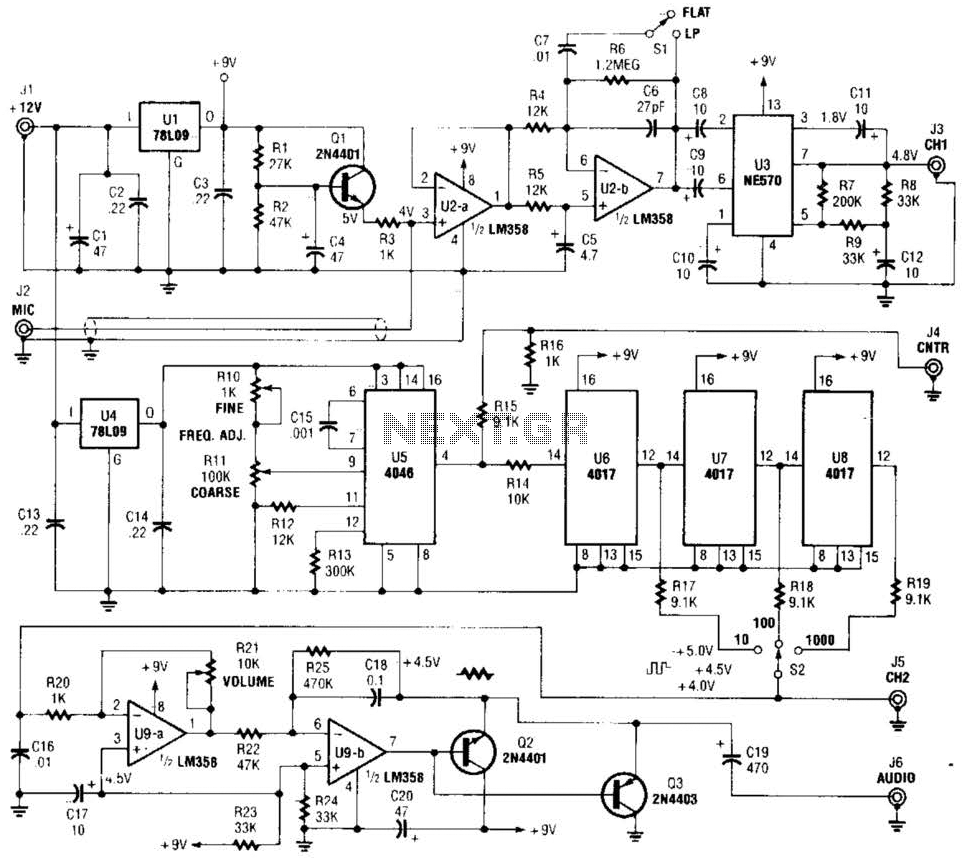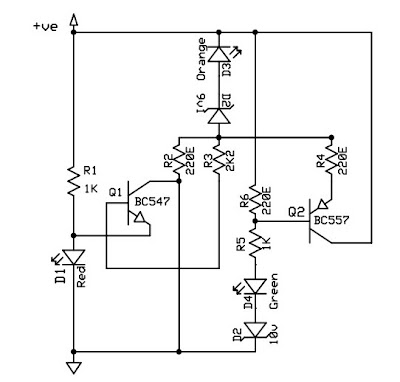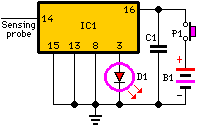
7 band audio graphic equalizer circuit

This circuit is for an audio equalizer that is commonly found in commercial products such as high-fidelity systems, car audio, and stage equipment; however, published circuits for these devices are quite rare. This design features equalizer bands. The circuit diagram of the audio equalizer project is provided. The circuit includes three formulas: the first determines the center frequency (f), the second relates the quality factor (Q) to the capacitor ratio, and the third describes the impedance presented by the circuit. It is important to note that this impedance comprises three components: the first is purely resistive, the second is the capacitive contribution from capacitor C1, and the third is an inductive term from the gyrator. The remaining part of the circuit consists of an operational amplifier (op-amp). The configuration can be visualized as a tuned circuit (the gyrator) connected to the slider of a potentiometer, which is linked to either the positive or negative input of the op-amp to varying degrees. Adjusting this connection will enhance the response at the tuned frequency while diminishing it at other frequencies.
The audio equalizer circuit is designed to manipulate audio signals by adjusting the amplitude of specific frequency bands, thereby allowing for a customized listening experience. The circuit typically uses multiple bands, each tuned to a specific frequency range, and operates by employing a gyrator circuit, which simulates an inductor using active components. In this configuration, the gyrator provides a variable inductance that can be finely adjusted through the potentiometer, allowing for precise control over the frequency response.
The three formulas integral to the operation of the circuit serve distinct purposes. The first formula calculates the center frequency (f) of each band, determining where the maximum gain occurs. The second formula establishes the relationship between the quality factor (Q) and the capacitor ratio, which affects the bandwidth of the frequency response. A higher Q indicates a narrower bandwidth, resulting in a sharper peak at the center frequency. Conversely, a lower Q yields a broader response, which can be beneficial for more general adjustments.
The impedance formula is crucial for understanding how the circuit interacts with the audio source and load. The resistive component represents the inherent resistance of the circuit elements, while the capacitive and inductive contributions modify the overall impedance at different frequencies. This interaction plays a significant role in the circuit's ability to filter and amplify specific audio signals effectively.
Operational amplifiers are central to the audio equalizer's functionality, as they provide the necessary gain and buffering for the audio signals. The op-amp configuration can be set up in various ways, such as inverting or non-inverting modes, to achieve the desired signal processing characteristics. The tuning of the gyrator circuit, in conjunction with the op-amp, allows for a versatile and responsive equalization process, making this audio equalizer suitable for a wide range of applications, from home audio systems to live sound reinforcement.This is circuit for audio equalizer that is very common as commercial products (for Hi-fi, car audio and stage use) but circuits for them are very rarely published. This circuit is like as equalizer bands. Here`s the circuit diagram of the audio equalizer project. The circuit includes three formula: one which gives f, the centre frequency of the b and. The second shows how the Q is related to the capacitor ratio. The third shows the impedance presented by the circuit. Note that this includes 3 terms, the first purely resistive, the second is the capacitive contribution from C1 and the third is an inductive term from the gyrator. The rest of the circuit is simply an op-amp. If you consider a `tuned circuit` (the gyrator) hanging from the pot slider, it is being connected either to the positive input or the negative to a variable extent.
One will increase the response at the turned frequency and the other will decrease it. 🔗 External reference
The audio equalizer circuit is designed to manipulate audio signals by adjusting the amplitude of specific frequency bands, thereby allowing for a customized listening experience. The circuit typically uses multiple bands, each tuned to a specific frequency range, and operates by employing a gyrator circuit, which simulates an inductor using active components. In this configuration, the gyrator provides a variable inductance that can be finely adjusted through the potentiometer, allowing for precise control over the frequency response.
The three formulas integral to the operation of the circuit serve distinct purposes. The first formula calculates the center frequency (f) of each band, determining where the maximum gain occurs. The second formula establishes the relationship between the quality factor (Q) and the capacitor ratio, which affects the bandwidth of the frequency response. A higher Q indicates a narrower bandwidth, resulting in a sharper peak at the center frequency. Conversely, a lower Q yields a broader response, which can be beneficial for more general adjustments.
The impedance formula is crucial for understanding how the circuit interacts with the audio source and load. The resistive component represents the inherent resistance of the circuit elements, while the capacitive and inductive contributions modify the overall impedance at different frequencies. This interaction plays a significant role in the circuit's ability to filter and amplify specific audio signals effectively.
Operational amplifiers are central to the audio equalizer's functionality, as they provide the necessary gain and buffering for the audio signals. The op-amp configuration can be set up in various ways, such as inverting or non-inverting modes, to achieve the desired signal processing characteristics. The tuning of the gyrator circuit, in conjunction with the op-amp, allows for a versatile and responsive equalization process, making this audio equalizer suitable for a wide range of applications, from home audio systems to live sound reinforcement.This is circuit for audio equalizer that is very common as commercial products (for Hi-fi, car audio and stage use) but circuits for them are very rarely published. This circuit is like as equalizer bands. Here`s the circuit diagram of the audio equalizer project. The circuit includes three formula: one which gives f, the centre frequency of the b and. The second shows how the Q is related to the capacitor ratio. The third shows the impedance presented by the circuit. Note that this includes 3 terms, the first purely resistive, the second is the capacitive contribution from C1 and the third is an inductive term from the gyrator. The rest of the circuit is simply an op-amp. If you consider a `tuned circuit` (the gyrator) hanging from the pot slider, it is being connected either to the positive input or the negative to a variable extent.
One will increase the response at the turned frequency and the other will decrease it. 🔗 External reference





